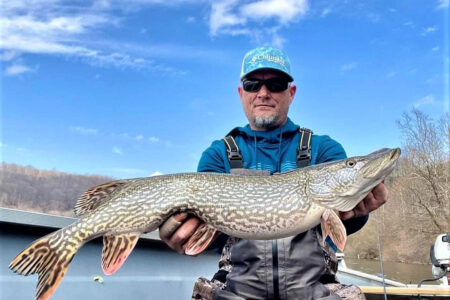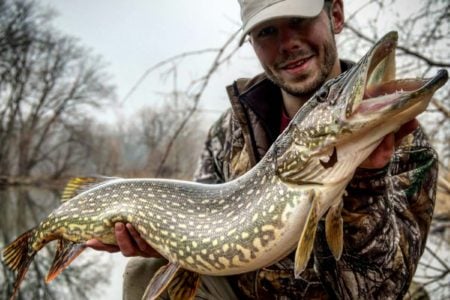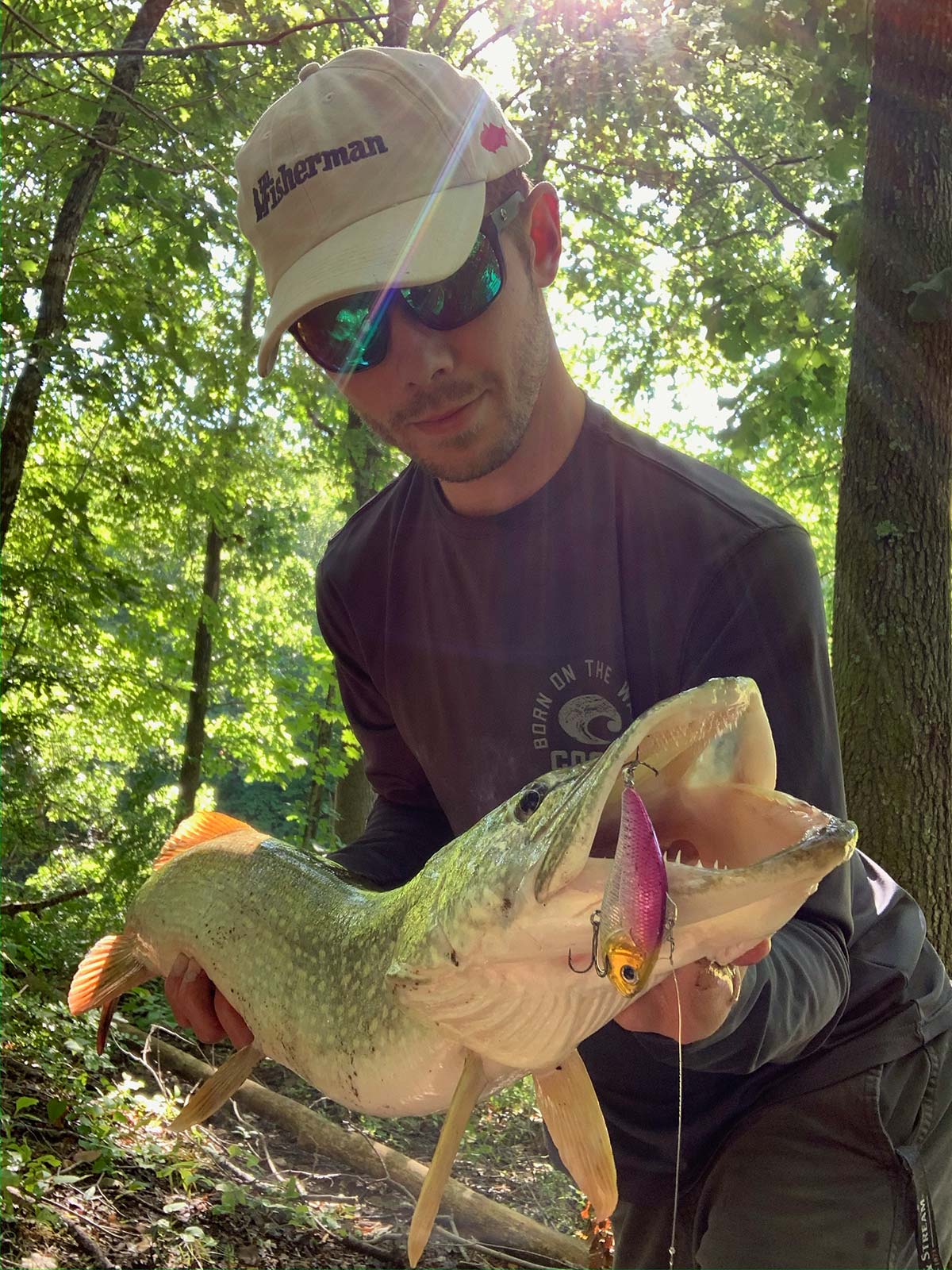
Targeting New England’s hardwater hero in the heat of the summer!
When pike fishing comes to mind most people think about the ice. It is probably the most popular way to target them because pike really are a cold water species. However, this doesn’t mean that they can’t be caught during the warmer months. In fact, if you know where to look the action can be awesome.
Like everything else, pike patterns go through seasonal changes. So when targeting them in the summer, they won’t necessarily be in the same places that you found them in the winter. There are a few key factors to take into consideration when searching for them. You want to be looking at water temps, finding those cooler areas of the lake is a good start. Also healthy weedlines that provide rich oxygen levels.
Lastly, abundant forage, as the old saying goes “find the bait and you’ll find the fish”. If you happen to come across an area that has the trifecta, then you’re in business.
An Apex Predator
Understanding your target species will increase your chances of catching them, obviously. Pike are known for their razor sharp teeth, aggression and a seemingly insatiable hunger for meat. In many bodies of water they’re the apex predators given their size and appetite. They’re able to swim 6 to 7 feet per second and will go after anything up to about half their size. I’ve even seen videos of them taking down baby ducks, turtles and bullfrogs as well, so truly nothing is safe from these toothy beasts. This includes acts of cannibalism as well. Which is why younger pike will stick together in smaller schools while bigger fish transition to becoming lone wolves. While they like to hunt, pike will also scavenge the bottom feeding on dead suckers and panfish for easy meals.
Pike are sight predators without a doubt. Just below their eyes there are grooves that run down towards the tip of their mouth. These grooves serve as sight lines for the pike. Kind of like staring down a double barrel shotgun. Loud and flashy baits are the way to go in order to get them to attack, if not out of hunger then out of aggression. As I mentioned before, pike will strike and attempt to eat things up to half their size. So upsizing your lures is also a good idea. I’m not saying that they won’t hit a smaller bait, but a larger presentation will help to weed out most other fish in order to keep you on your target species.
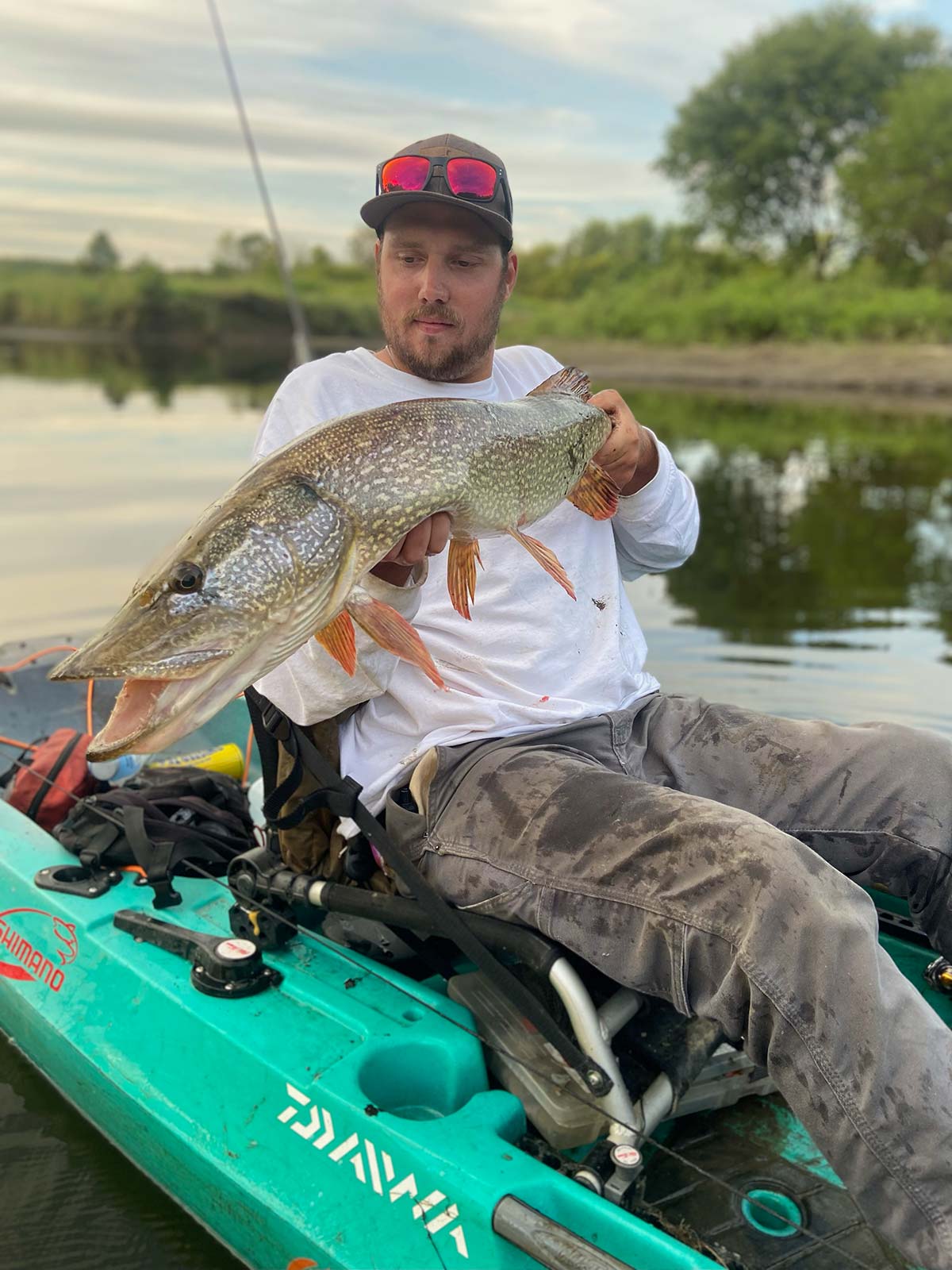
Cooler Waters
As water temps climb in the heat of those summer months pike will take refuge in cooler, deeper or shadier areas, as most fish do. Time of day is a huge factor when chasing pike during the heat of the summer. The first and last few hours of each day will be the best times to search for northerns. During the day the bite usually slows down a bit unless you’re in deeper water. Personally, I enjoy fishing backwater coves. These areas are often panfish havens with strong weedlines for them to forage as well. There is a plethora of aquatic insects and baitfish in the weeds that panfish such as perch, sunfish and rock bass stay busy pursuing. But the food chain doesn’t stop there, the pike take notice of these activities as well.
Other areas to look for pike during the heat of those summer months are deeper edges along rocky points that abut strong drop-offs and pinch points. There is only so much real estate in coves for northerns and a lot of other fish tend to slip down a bit deeper to beat the heat. Trolling spoons or deep diving crankbaits can pull fish out of these deeper locations. Rocky points that drop off provide cover and structure for foraging with the added benefit of colder water. Pinch points are good areas, especially along river systems where the current gets a little stronger with cooler flows. Usually areas with a bridge will give you this scenario and pike love bridges. Abutments make great ambush points for pike as well. Cruising along spots like these at 2 to 3 miles per hour is just about perfect. Fish will come off the bottom and up to 10 feet just to smack a big, slow wobbling crank.
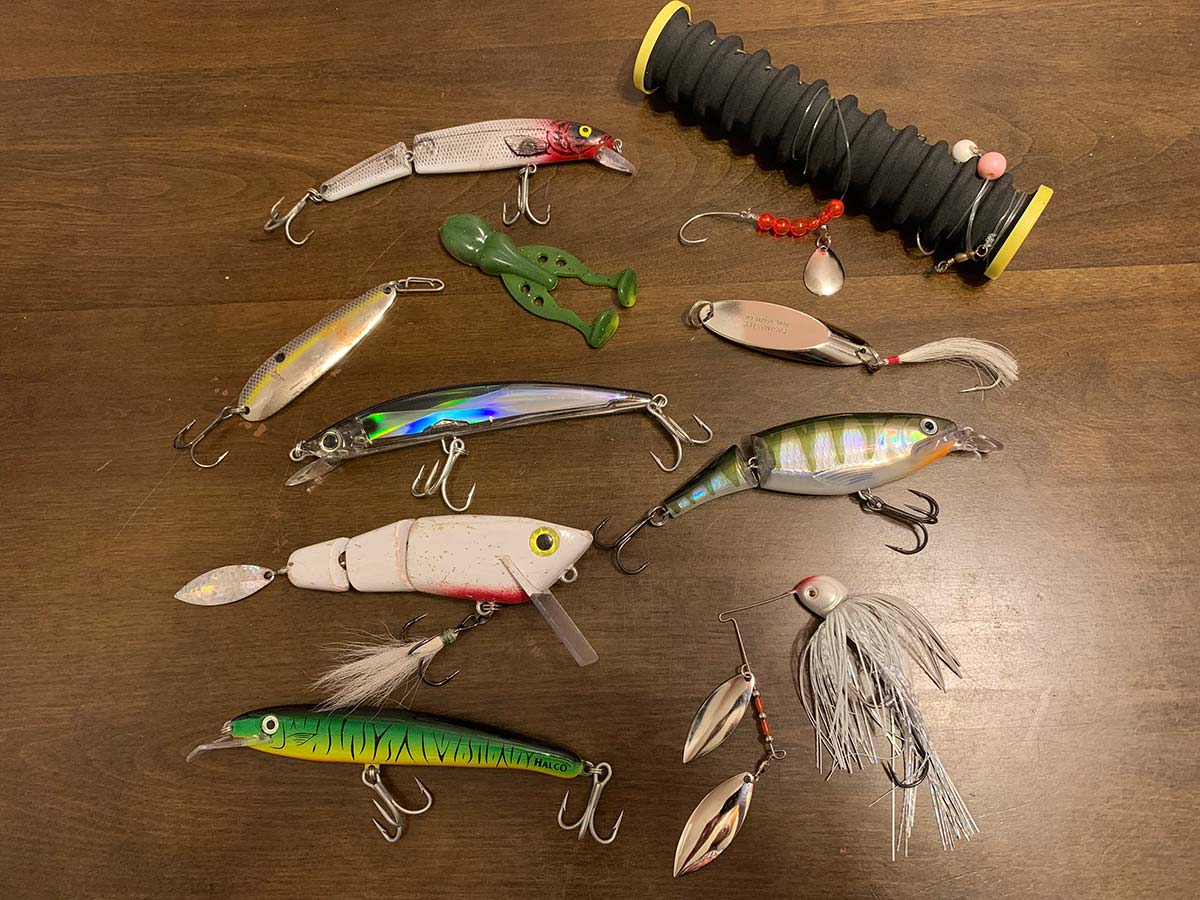
Flashy & Noisy
Some of my favorite lures to chase pike with are big spinnerbaits, inline spinners, jointed swimbaits, rattle traps and spoons. Throwing at the edge of weedlines or casting parallel to them is key. The edge of these weedlines are where northerns are most likely to be sitting. Larger spinnerbaits and inline spinners emit a ton of noise and flash which is very hard for pike to ignore. When it comes to jointed swimbaits, I am quite partial to the Rapala X-Rap jointed shad (XJS13). There are also a ton of companies that make sweet custom baits like River Snacks which are made right in my home state of Connecticut. A Rat-L-Trap type bait that I’ve also had great success with is the 5/8-ounce Z-Viber from Eurotackle.
Jumbo spoons are a sure bet for pike as they resemble an injured baitfish. For smaller spoons the classic Daredevil still gets bites, but I prefer the updated spoons from Krocodile, Kastmaster and Michigan Stinger. They cast a mile, cover a lot of water and are also great for trolling and jigging. Additionally, a lot of my striper and bluefish gear is also in my pike arsenal. Big baits with beefy galvanized steel hooks are perfect for the job and can hold up to any northern out there.
But nothing is more productive than throwing live bait. Just remember that bigger is better. Some people feel that pike prefer softer rayed fish such as sucker, pond shiners and dace. I however, have caught a ton of fish on live bluegills and yellow perch. No pike would pass up an easy meal of sunfish or perch. I usually use an 8/0 octopus or octopus circle hook for bait fishing. Some anglers prefer trebles but I find that the extra hooks tend to attract more junk and weeds. Strategically casting to the edges of weedlines so that your bait is free to swim about and get noticed is the way to go. If you’re fishing coves with thick cover try looking for holes in the weeds. Dropping your bait down into a small pocket of open water in a field of green can produce great results.
Murkier water may call for a little added flare. Adding some beads and/or a #2 or #3 Colorado blade above your bait adds significant sound, vibration and flash. Something as simple as that can greatly increase your chances of getting bit. But definitely don’t be shy about throwing a frog on any solid weed cover early or late in the day. These fish will actively pursue topwater prey (frogs, dragon flies, snakes) if the opportunity presents itself.
Rigging Right
For a rod I like to use a 7- to a 7-1/2-foot medium heavy set up. I have a St. Croix Triumph paired with a 2500 series Shimano Sedona reel. It is a well-balanced setup and I spool it with 30-pound Power Pro braid. Braid is excellent for distance and strength which are two very important things to look at in a line when fishing for pike. It also slices right through weeds so you won’t get hung up like you would with mono. Just don’t forget about the leader material.
I avoid steel leaders; it’s one thing if you’re burning a spinner quickly and a fish has to react or miss out, but even then they can become leader shy. It is even more important to achieve maximum transparency when fishing something slow and methodically or with bait where the pike are able to get a good look at your presentation before choosing to take a swipe at it or not. I use 12 to 18 inches of 60-pound fluorocarbon to prevent any heartache at the hands of Mr. Toothy. TA clips are a must to swap out baits as needed and they’re super durable as well. Much stronger for their size than a traditional snap swivel.
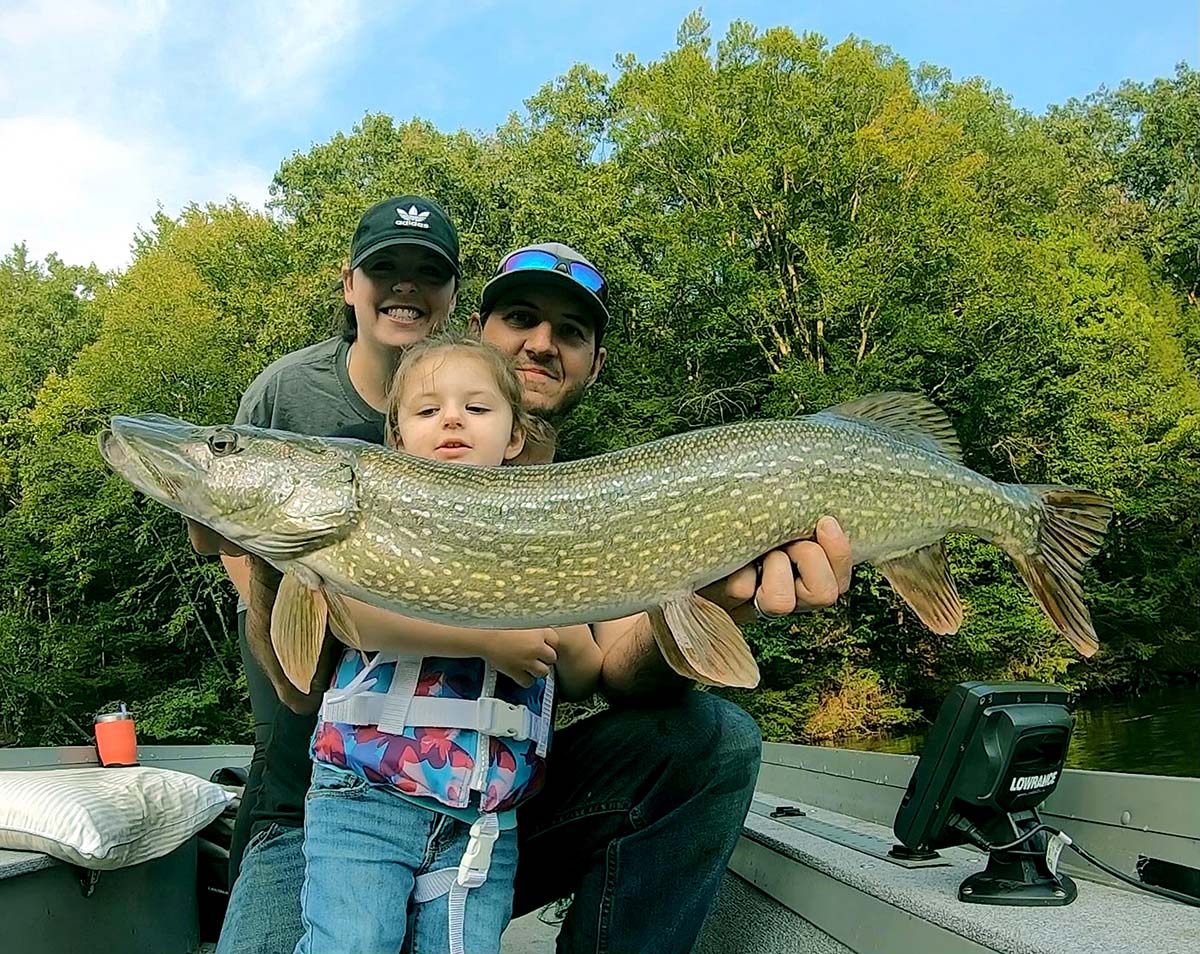
Landing & Handling
Handle these fish with care; that will benefit both you and the fish. Their razor sharp teeth can cut you open with ease. Stay away from lip grippers though, people often feel that you need them for toothy fish but they can do a lot of damage. They can punch large holes through their lips and, if the fish thrashes, may even split their lower lip which will dramatically limit their ability to feed.
These are very avoidable injuries if you use a rubberized net (regular knotted nets can tear fins), or also by handling the fish yourself by grabbing it under the gill plate then quickly supporting its weight with your other hand under its belly. Once unhooked, be sure to give the fish time to recover. Warmer water requires more recovery and revival time. Just tossing fishing back in without properly caring for it may prove fatal, even if “it swam off just fine”. Snap a quick picture and get the fish back in the water.
Pike fishing is not just a wintertime fishery here in New England, there are great opportunities to connect with these fish in the summer and into the fall. If you don’t know where to go to catch some pike, check your state’s fisheries website and for information on bodies of water that have been stocked with pike. Another good tip is to fish ahead of big storms like summer Nor’easters or weakening tropical systems—these tend to get the fish feeding aggressively. If you’re looking for a change a pace of this month, try targeting New England’s apex freshwater predator and be ready for a battle!
